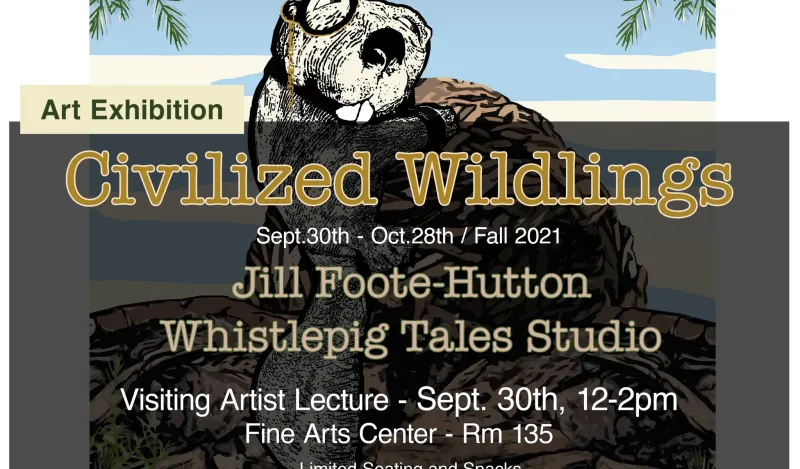
EVENT INFO:
Visiting Artist Lecture
September 30th – October 28th, 2021
Artist Talk on September 30th from 12-2pm
Location: NHCC – Fine Arts Center – 135
Gallery Hours
9am-8pm Monday
12-4pm Tuesday
Or by appointment.
A Description:
The exhibition will consist of a collection of vessels informed by art nouveau pottery made in Bohemia at the turn of the century by Eduard Stellmacher, whose works were a celebration of the natural world. His forms were harmonious curves crawling with creatures from the forest with thick details and opulent glazes. But the flora and fauna crawling over and growing around the forms created by Jill Foote-Hutton are decidedly more anthropomorphized, sometimes comically so. Working in layers, both formally and conceptually, the creatures are portrayed wearing hats, monocles, cuffs, and sometimes Victorian collars – an allusion to the habit of the conquering classes around the world who have historically tried to tame and civilize that which has been deemed wild. The effect is comical. The comedy is meant to show how ludicrous the narrow margins of establishment can be. The works are also a celebration of the wisdom of nature and all it has taught humanity throughout time, if we are willing to learn. Viewers may note three repeating symbols in the works that are ever more consistent iconography in Foote-Hutton’s work: a wind-up key, the external force; a bean, adzuki or black-eyed pea, this is a nod to parallel traditions in disparate cultures; a ball, a simple, accessible form that engages the body, creates community, and can be a bridge from one realm of existence to another. On the walls surrounding the vessels, there are digital prints; two-dimensional illustrations of the vessels and the creatures that inhabit them. Here the artist takes inspiration from the graphic qualities of national park posters and creates a polychromatic “book” of sorts, educating viewers about habitat, behavior, or threats to the existence of the animals she portrays. Each image denotes a location and a time: Red Lodge, Montana, Caulfield, Missouri, or Two Harbors, Minnesota. Foote-Hutton makes note of the wildlife she encounters or learns of in her travels, researching the habits and symbolism along the way. She refers to this practice as nomadic regionalism, a parameter guiding her practice since 2015.
ARTIST STATEMENT:
Civilized Wildings began to form in my imagination when I happened upon the most wonderous book in the library at Northern Clay Center, Monsters & Maidens: Amphora Pottery of the Art Nouveau Era by Byron Vreeland. As a person who firmly believes in the power of fiction – to relate truth, to reveal new perspectives on our world – my mind exploded seeing vases that swelled and curved. There volume was a habitat for dragons to crawl over, bats could fly into the depth of the glaze, spider webs overlapped and reiterated the form, and the handles grew rampant – impossible vines.
For years I have looked to nature to create fanciful beings I call Guardian Monsters. They are amalgamations of characteristics I have observed in creatures at specific locations in nature. They are surreal. They are usually disembodied, in that they are busts, but they all have a story and a habitat and gave me a foundation for combining my love of narrative and illustration.
With Civilized Wildings I allow myself to stay more true to the creature as I observe it in nature. But I still take liberties. That’s the beauty of anthropomorphism. Working in layers, both formally and conceptually, the creatures are portrayed wearing hats, monocles, cuffs, and sometimes Victorian collars – an allusion to the habit of the conquering classes around the world who have historically tried to tame and civilize that which has been deemed wild. The effect can be comical. The comedy is meant to show how ludicrous the narrow margins of establishment can be.
The works herein are also a celebration of the wisdom of nature and all it has taught humanity throughout time, if we were willing to learn.
Smaller bits of iconography:
- The wind-up key is external force.
- The bean is indicative of the adzuki bean or black-eyed pea. Both are used to call fortune home and are a nod to parallel traditions in disparate cultures
- The Gordian Knot is the ability to use creative and critical thinking.
- The ball takes many forms around the world and is a simple, accessible thing that engages the body, creates community, and can be a bridge from one realm of existence to another.
Nomadic Regionalism was first a reference to a peripatetic lifestyle. More than that, nomadic regionalism is an acknowledgement that all of my experiences and observations wind up being translated into specific objects I make and their stories. The beaver you see here today, is from Red Lodge, Montana. He crossed the road in front of me after a rainstorm. The gray myotis once dominated the night skies in southern Missouri; and other locales too, but I became aware of the species on a float trip on the North Fork of the White River. The landscapes I travel through by boat, foot, bike, car, or while swimming underwater, provide the fodder for my work. They can teach us about this world and about ourselves.
ARTIST WEBSITE:
http://www.whistlepigtales.com/whistlepigstudio
